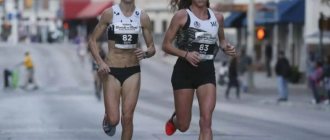How to run 1 km without training and not die? Or 1 km and 2 km very fast? And do this in such a way as not to lose interest in running for the year ahead until the next New Year’s “To Do” list.
Imagine walking outside in your brand new running shoes and workout gear. The spring sun gently warms your skin, and the warm wind whispers in your ear that you will definitely succeed. You start running at cruising speed, but after about 200 meters the pain in your side and the fire in your lungs slow you down. By the time you finish, you're already thinking that becoming a sprinter was a bad idea. But you should not immediately discard this idea. Surely not everyone likes long-distance running. Some people are driven by speed.
In order to learn how to run 1 km quickly, easily and without stopping, just follow a simple training plan. And the next distance of 2 km will follow. However, the tactics of running for 2 km are not very different from the first kilometer. But first things first.
Further:
Standards for running 2000 meters
Men's
With a water pit:
| Adults | Youth | |||||||
| MSMK | MS | KMS | I | II | III | I | II | III |
| — | 5:45.24 | 6:00.24 | 6:20.24 | 6:46.24 | 7:18.24 | 7:48.24 | — | — |
Without water pit:
| Adults | Youth | |||||||
| MSMK | MS | KMS | I | II | III | I | II | III |
| — | 5:36.24 | 5:50.24 | 6:09.24 | 6:38.24 | 7:05.24 | 7:34.24 | — | — |
Women's
With a water pit:
| Adults | Youth | |||||||
| MSMK | MS | KMS | I | II | III | I | II | III |
| — | 6:35.24 | 6:54.24 | 7:21.24 | 7:53.24 | 8:32.24 | 9:28.24 | — | — |
Without water pit:
| Adults | Youth | |||||||
| MSMK | MS | KMS | I | II | III | I | II | III |
| — | 6:25.24 | 6:43.24 | 7:09.24 | 7:40.24 | 8:18.24 | 9:12.24 | — | — |
Youth (9th grade)
| Boys | Girls | ||||
| Grade | |||||
| 5 | 4 | 3 | 5 | 4 | 3 |
| 8:20 | 9:20 | 9:45 | 10:00 | 11:20 | 12:05 |
Boys in grades 10-11 most often take the distance of 3000 meters, while the distance for girls remains the same. You can familiarize yourself with the standards for grades 10-11 by following the link.
Running program - 3 km in 12 minutes
One of the rules is consistency. Just start running regularly. Running is not a strength exercise, where sometimes a short break gives positive dynamics. I stopped running a little and added one minute to the time.
Day 1 – 5-10 km at an easy pace;
Day 2 – 2 km fast, 2 minute pause x 3 times;
4th day – 12 minutes quickly;
Day 5 – 7-10 km at an easy pace;
Days 3,6 and 7 – rest or active recreation.
If we take into account that strength training is still my main sport, then while gaining strength, I train in the gym all the days, if I just keep in shape, then strength training twice a week, where at the beginning of training 2 km at a competitive pace and one day of easy running.
World records in the 2000 meters
The 2000m race is not included in the Olympic Games or World Championships. However, races over this distance are still held, and the best results are recorded and recognized by the IAAF.
Men
| Record set | Record holder | A country | Place | date |
| 4:44.79 | Hisham El Guerrouj | MOROCCO | Berlin (Olympic Stadium) | 07 September 1999 |
Women
| Record set | Record holder | A country | Place | date |
| 5:23.75 | Genzebe Dibaba | ETHIOPIA | Sabadell (PC Catalunya) | 07 February 2017 |
For the IAAF to recognize a world record as valid, it must meet several rules:
- The athlete is required to submit a doping test to the IAAF committee immediately after setting a record;
- The race must involve at least 2 people of the same gender;
- Stadium markings must comply with IAAF requirements;
- IAAF rules prohibit saving energy at the expense of the pacemaker, hiding behind his back in order to reduce wind resistance.
A little personal history
One day I was preparing for a running competition at a stadium in the city where I live. A magnificent place on the Black Sea coast. And I was lucky enough to run with someone who changed the way I thought about breathing while running. I often try to look closely at people who are stronger and faster than me. Monitor their technique, breathing and exercises. And he told a simple philosophy of breathing. You need to breathe evenly and not as often as I did. At the same time, deeply smell the sea, listen to the wind, listen to the cries of seagulls and try to relax. Something like meditation, only in motion.
Of course, I tried to breathe like this and did not immediately understand all the subtleties. Practicing all the time, it dawned on me! You need to breathe deeply and in such a way, as if after a nervous situation or conversation you are trying to calm down, inhaling deeply and exhaling smoothly. Breaaaaaaaaaaaaaaaaaaaaaaaaaaand! This way I manage to lower my heart rate (pulse).
Running technique
Completing a distance of 2000 meters with maximum results requires an athlete to master a high level of running technique. Mastering the technique allows you to use your strength at a distance most effectively and run each segment of the distance at the pace necessary to achieve your goal.
Mastering the technique occurs with the help of special exercises. All technology is divided into 3 stages:
- Start and starting acceleration;
- Distance running;
- Finishing.
Start and starting acceleration
In the 2 km run, a high start is used, since using a low start in this case has no practical benefit. All athletes line up along the starting line. The pushing leg is placed in front of the line (stepping on the line is prohibited), and the swing leg is pulled back. Both legs are bent, the torso is tilted forward. If desired, the athlete can touch the surface of the track with his hand, but within the starting line.
After the command “March” the athlete begins the starting acceleration. At the same time, the torso is still tilted forward, which allows you to gain starting speed in a minimum period of time. The arms are bent at the elbows 90 degrees and perform opposite movements with the legs: right leg – left arm, left leg – right arm.
Distance running
At this stage, the athlete has gained speed and varies the pace depending on the chosen running tactics. The average step length ranges from 190 to 220 cm. In 1 second, the athlete performs from 3.5 to 4.5 steps.
The torso is tilted forward 4-5 degrees, which creates an inertial force that facilitates forward movement. The shoulder girdle is relaxed. Proper hand function allows you to maintain balance while running.
The most effective push-off occurs at an angle of 50-55 degrees and is characterized by full straightening of the leg in the future. After repulsion, the athlete’s body is in the flight phase. The longer the flight phase, the more speed the athlete loses. Therefore, it is important to reduce the flight phase to a minimum.
Landing occurs on the leg bent at the knee, as this allows you not only to prepare for future repulsion, but also to soften the impact force upon landing. After pushing off, the muscles of the leg relax, which contributes to its relaxation. At this moment, the second leg moves forward and prepares to push off.
The delivery of the foot occurs in an active mode, which allows you to save energy, which in the case of passive planting of the foot would be needed for new muscle tension. During the push-off, the emphasis should be on pushing through the big toe. In this case, the toe is slightly turned inward.
When cornering, your torso is directed toward the inside of the treadmill. At the same time, the foot of the right foot turns outward with the heel. The right hand is actively working.
In a condensed version, the technique looks like this:
- The body is tilted forward 4-5 degrees;
- Shoulders relaxed and straightened;
- The pelvis moves forward;
- The chin is slightly down.
Finishing
When finishing, the athlete uses the remaining energy for the final push. 200-400 meters before the finish line, the body leans forward again, as during the starting acceleration. The length and frequency of steps increases. At the finish line in the 2000 meter race, the technique becomes more and more reminiscent of a sprint.
At this section of the distance, you can easily understand how correctly the forces were distributed along the distance. It often happens that in the desire to save strength for the final push after the finish, an athlete feels that there is still strength left. Or, conversely, in the last 100-200 meters there is a sharp decrease in pace. These are signs that the tactics of passing the distance require adjustment.
After finishing, be sure to cool down. At least 1 lap at a pace that is more like an easy walk.
We run 3 kilometers without preparation
If you didn’t play sports after school, and also ignored all the tips listed above for preparing for the standards, then passing them will be much more difficult. Running 3 km takes a lot of energy and requires endurance. Therefore, we will give some useful recommendations that will help you cope with such a difficult task:
- Be sure to warm up immediately before going on the treadmill. Just a few simple exercises performed at a fast pace will warm up your muscles and allow you to cope even with heavy physical activity;
- Don't dress too warmly. While running, you will heat up in any case, but fairly heavy winter clothing can significantly increase the load;
- It is best to start the distance approximately 40-60 minutes after eating. Otherwise, you will feel serious discomfort and will not be able to even out your breathing;
- hurry up slowly. At a distance of three kilometers, you shouldn’t immediately waste your energy trying to take the lead. Start the distance with an easy and calm run, do not rush anywhere, so as not to immediately lose your breath. Using this approach, you will be able to save maximum energy by the end of the second kilometer and speed up significantly;
- breathe correctly. Ideally, for each step there should be one short inhalation and an equally short exhalation. When you pick up speed, it is better to exhale as sharply as possible - then the lungs will draw in air themselves, making the task as easy as possible for you;
- To minimize the negative impact on the body that can result from lack of habit, do not stop immediately after completing the distance. Run another 300-400 metro, gradually slowing down the pace and restoring your breathing.
Even if you haven’t exercised for a long time, all these recommendations will allow you to overcome a three-kilometer distance with minimal discomfort and give you the opportunity to show completely normal results.
Many athletes strive to meet the GTO standard, and more specifically, to run three kilometers in twelve minutes. Both experienced athletes and beginners have a desire to fulfill such standards, however, as a rule, only trained athletes can achieve such a result.
In order to show such an excellent result, it is necessary to conduct regular running training, eat right, lose excess weight, strengthen the body, and give up bad habits.
Runners who set themselves the goal of running three kilometers in 12 minutes need to actively train and develop:
- speed,
- oxygen use efficiency,
- aerobic strength.
Training program
A training program for the 2000 meter run may contain:
- General endurance training;
- Interval running to develop speed-strength endurance;
- Running in competitive mode.
Running 2000 meters requires the athlete to have well-developed general endurance. Therefore, it is important to include a large running volume in your training program. In this case, the pace should be close to jogging.
An equally important point is the athlete’s ability to maintain the same pace for a long time. To do this, you can use fitness bracelets or special running applications that will record the time spent completing each kilometer of the distance and show time deviations at each segment.
The next type of training is interval running. The athlete runs segments at 70-80% of maximum speed. Rest is 2 minutes. The standard number of repetitions is 10 segments, but can reach 20 or more repetitions.
The training program also includes jerky running, which is similar in nature to interval running. The athlete runs 300-500 meters at a slow pace, and then accelerates 100-200 meters and starts jogging again. This run can last from 1000 to 5000 meters.
The competitive nature of training is used not only to develop the athlete’s physical qualities, but also moral ones. The athlete must cope with anxiety during the race and perform to the best of his ability. If an athlete is unable to cope with anxiety, then no matter what the results in training are, the results in competitions may be much worse. On the contrary, if a runner has a strong psyche and is able to fight with opponents, then he will show a better result compared to what he showed in training.
Minimal preparation to help you easily cover a distance of 3 kilometers
The first tip to help you get fit enough to complete a 3K run without problems is to start training for your run early. We are sure that not everyone will listen to him, but we will definitely tell you how to adapt your body to increased physical activity. This is in your interests - if you know about the draft, you should be prepared to pass the sports standards. Preliminary preparation will allow you not to lose face in front of your future colleagues and not become an object of their ridicule in the coming months.
How to prepare for running standards? Just follow the recommendations below:
- Do a warm-up run every day for 10-15 minutes. After just a few days of such simple and short exercises, you will see that your body copes with the load much easier, and your breathing returns to normal;
- Try running your usual distance with special weights. This will significantly increase endurance and improve physical fitness. In addition, running speed will increase significantly;
- Do exercises to develop your calf muscles, hamstrings and quadriceps. Muscle mass will significantly increase your running speed, and will also increase endurance at distances such as 3 or 5 km.
Is it possible to cope well with the 3 km running standard without such preliminary preparation? Yes, you can. But for this you will need, firstly, to make significant efforts, and secondly, to follow our recommendations.
Recommendations
After the start, immediately pick up the speed with which you will move along the distance. If the race takes place at a competition, then it is advisable to gain a foothold among the leading athletes, since catching up is always more difficult than staying behind your opponent.
Before the race, distribute your strength and stick to the pace. The drop in pace should not be significant, otherwise it will be difficult to return to the required speed. Allowing yourself to rest and slow down is not a good idea for middle distance running.
100-200 meters before the finish, increase your step frequency. At the same time, control your energy consumption so that at the finish line you at least do not lose speed. After finishing, be sure to cool down by running slowly. This will allow the muscles to recover faster and relieve severe muscle pain the next day.
Constantly work not only on the physical component of training, but also on technical, tactical and psychological ones. Only training of all these components will allow you to show the best possible result, regardless of whether you pass the standard, participate in competitions or set personal records in individual runs.
Cardiovascular system and breathing when running
There are no pathologies, I don’t smoke, the training load system is gradual. After reading articles from other sources, it turned out that smokers can forget about this standard. I can’t agree with this, there are unique people, but still I was very lucky in this regard. But I’ll also note that I smoked 12 years ago.
As for breathing, you can often find a breathing technique when running 3 km - inhale for two steps and exhale for two steps. I used this technique all the time. During such breathing, in my case, the bullets immediately became more frequent. In turn, you won’t run far at a high heart rate.
Drink water before and during the run
If there's one thing you need to remember: hydration is essential. A huge number of runners underestimate their water needs. Drink at least 500-700 ml a few hours before the race and 100 ml every 15 minutes while running.
The best way to tell if you're well hydrated is to check the color of your urine after the race. If it's dark yellow or the color of lemonade, you need to drink more water while running. If it is pale yellow, you are properly hydrated. A lack of fluid and electrolytes in the blood can cause muscle cramps and fatigue. So, drink water!
Check your running gear during training
The choice of running equipment is also important: you need to be comfortable. To do this, test your starting clothing and shoes during training. It is important to understand that your preparation, as well as the start, should be fun, without harm to your health.
Photo: vk.com/runcomrun
It is best to train and run competitions with a gadget that will help you monitor your pace, distance and - most importantly - your heart rate. Thanks to this, you will be able to start the distance by planning in advance those heart rate indicators at which your strength will not leave you in the first couple of kilometers, and complete the race with pleasure and benefit.
Experiment to find what works best for you
Taking up running can be an exciting process, but the amount of new information you get about the sport online can be overwhelming. It probably goes something like this: load up on carbs, but don't overdo it; eat protein, but not too much; avoid fats; drink water, but not too much. And then your head just explodes.
The truth is that we are all different, and what doesn't work for someone else may work great for you. So experiment with foods you already enjoy (no, we're not talking about chocolate bars, we're talking about healthy foods) and make sure to control your portion sizes. You'll quickly figure out which foods give you the most energy and don't have you running to the bathroom mid-run.
Like that:
| More running | More strength | I support | |
| Monday | Run | Power | |
| Tuesday | Run | Power | Strength, Running |
| Wednesday | |||
| Thursday | Run | Power | Strength, Running |
| Friday | Run | Power | |
| Saturday | Power | ||
| Sunday | Power | Run | Strength, Running |
Carbohydrate before your race
Keep in mind that you need to load with carbohydrates correctly. 2-3 hours before the race you need to consume complex carbohydrates such as whole grains, potatoes and legumes. Simple carbohydrates, such as fruit, are best eaten an hour before your race.
Yes, carbohydrates are the #1 fuel and provide you with the energy to run. But, that doesn't mean you need to eat a bowl of pasta before a short run (sorry), but oatmeal for breakfast or potatoes and salad for lunch are good choices of complex carbohydrates.
Who's the hero?
34-year-old Kenyan Eliud Kipchoge is one of the main heroes of modern athletics, the owner of a solid collection of awards in the long run. He is the Rio 2016 Olympic champion in the marathon, the current world record holder for this distance (2:01.39) and a multiple winner of marathon races in London, Berlin and Chicago. However, Kipchoge has long wanted to add a truly historic achievement to his resume: “I run to show that man has no boundaries.” The Ineos 1:59 Challenge, planned specifically to set a record, was not Kipchoge’s first attempt to “run out of two hours.” In 2022, Nike organized a commercial race called Breaking2, inviting three runners to participate, including Kipchoge. For the event, we developed special equipment, selected a group of pacemakers (assistant runners who maintained the pace of the race) and rented a Formula 1 track in Monza, Italy. Then Kipchoge won, but did not make it within two hours - 2:00.25. “We climb a tree. I have overcome another branch and am moving on to the next one. This is not the last attempt,” Eliud said after the finish.
Why is there no official record?
The International Athletics Federation (IAAF) will not count Kipchoge's historic result as an official record. Firstly, it was a closed race, and secondly, too many orchestrated circumstances influenced the result - well-functioning work of pacemakers, food and water “delivered”, etc.
However, the marketing effectiveness of the project did not suffer from this. Kipchoge made history as the first person to run a marathon under two hours. There is a lot of hype around Nike sneakers: the IAAF has already announced that it will look into how much new technologies speed up running. Ineos reached 120,000 viewers in Vienna and nearly half a billion television viewers worldwide. By the way, about 650 million people watched Neil Armstrong’s steps on the lunar surface in 1969 on TV.











